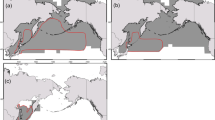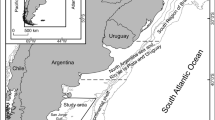Abstract
This paper explores the benefits of including age structure in the control rule (HCR) when decision makers regard their (age-structured) models as approximations. We find that introducing age structure into the HCR reduces both the volatility of the spawning biomass and the yield. Although the benefits are lower at a fairly imprecise level, there are still major advantages for the actual precision with which the case study is assessed. Moreover, we find that when age-structure is included in the HCR the relative ranking of different policies in terms of variance in biomass and yield does not differ. These results are shown both theoretically and numerically by applying the model to the Southern Hake fishery.





Similar content being viewed by others
Notes
These are usually related to the size of the stock biomass and the fishing mortality associated with that stock size, (see Caddy and Mahon 1995)
To prevent the dynamics from exploding, we assume that \(\rho <1\).
One problem of this type of stock dynamics is how to deal with the last age group. For the purposes of this exercise, we can assume that all adults which are not caught die, thus simulating a maximum surviving age.
Note that only a fraction of adults are spawners given that \( \log N_{t,2}< N_{t,2}\) and that this fraction \(\frac{ \log N_{t,2}}{N_{t,2}}\) is decreasing. Moreover with constant weight-at-age, numbers are equivalent to biomass in our two-class model.
In this paper we use the Maximum Sustainable Yield, but any other reference point can be applied Dichmont et al. (2006)
This occurs because when taking differences, \(B_{t+1} - B_{tar}= (z_t - F_t-m)-( z_{tar}- F_{tar}- m)\).
In this simplified case, the optimal harvest rule is independent of the age structure of the biological population. This is due to the simple dynamics imposed on the problem, i.e. that only adults are spawners.
We are indebted to an anonymous referee for this suggestion.
We assume that, \(\hat{I}_{t}\simeq \sum _{a=1}^A \left. \frac{\partial Y}{\partial x_{a,t}} \right| _{x=x_{max}} + \left. \frac{\partial Y}{\partial F_{t} } \right| _{F=F_{max}} F_{t} \).
Remember that age-structured HCR was designed to minimize volatilities (see Eq. 1).
References
Baranov FI (1918) On the question of the biological basis of fisheries. Inst Sci Ichthyol Invest Proc 1(1):81128
Beddington JR, Agnew DJ, Clark CW (2007) Current problems in the management of marine fisheries. Science 316(5832):1713–1716
Beverton RJH, Holt SJ (1957) On the dynamics of exploited fish populations, fishery investigations series II, vol XIX. Ministry of Agriculture, Fisheries and Food, London
Caddy JF, Mahon R (1995) Reference points for fisheries management. FAO fisheries technical paper no. 347, FAO
Clark CW, Edwards G, Friedlaender M (1973) The Beverton-Holt model of commercial fisheries: optimal dynamics. J Fish Res Board Can 30(40):1629
Cope JM, Punt AE (2007) Admitting ageing error when fitting growth curves: an example using the von Bertalanffy growth function with random effects. Can J Fish Aquat Sci 64(2):205–218
Council Regulation COM (2011) 417, Final of 13 July 2011. Proposal for a Regulation of the European Parliament and of the Council on the Common Fisheries Policy
Da Rocha JM, Cervino S, Gutierrez MJ (2010) An endogenous bioeconomic optimization algorithm to evaluate recovery plans: an application to southern hake. ICES J Mar Sci 67:19571962
Da Rocha JM, Gutierrez MJ (2011) Lessons from the long-term management plan for Northern Hake stock: could the economic assessment have accepted it? ICES J Mar Sci 68(9):1937194
Da Rocha JM, Gutierrez MJ, Antelo LT (2012) Pulse vs optimal stationary fishing: The Northern stock of hake. Fish Res 121122:5162
Da Rocha JM, Gutierrez MJ, Cervino S (2012) Reference points based on dynamic optimization: a versatile algorithm for mixed-fishery management with bioeconomic age-structured models. ICES J Mar Sci 69:660669
Da Rocha JM, Gutierrez MJ, Antelo LT (2013) Selectivity, pulse fishing and endogenous lifespan in Beverton–Holt models. Environ Resour Econ 54:139–154
Deroba JJ, Bence JR (2008) A review of harvest policies: understanding relative performance of control rules. Fish Res 210–223
Dichmont CM, Denga AR, Punt AE, Venables W, Haddon M (2006) Management strategies for short lived species: the case of Australias northern prawn fishery. 2. Choosing appropriate management strategies using input controls. Fish Res 82:221–234
Dichmont CM, Pascoe S, Kompas T, Punt AE, Deng R (2010) On implementing maximum economic yield in commercial fisheries. Proc Natl Acad Sci USA 107:1621
Diekert FK, Hjermann DO, Naevdal E (2010) Spare the young fish: optimal harvesting policies for North-East Arctic cod. Environ Res Econ 47:455475
Francis RLCC, Mace PM (2005) An evaluation of some alternative harvest strategies. New Zealand fisheries assessment report 2005/60.30p
Grafton RQ, Kompas T, Hilborn RW (2007) Economics of overexploitation revisited. Science 318:1601
Hannesson R (1975) Fishery dynamics: a North Atlantic cod fishery. Can J Econ 8:151–173
Hilborn R, Walters CJ (2001) Quantitative fisheries stock assesment: choice, dynamics and uncertainty. Chapman and Hall Inc., London
Horwood JW, Whittle P (1986) Optimal control in the neighborhood of an optimal equilibrium with examples from fisheries models. IMA J Math Appl Med Biol 3:129–142
Horwood JW, Whittle P (1986b) The optimal harvest from a multicohort stock. IMA J Math Appl Med Biol 3:143–155
Kell LT, De Oliveira JAA, Punt AE, McAllister MK, Kuikka S (2006) Operational management procedures: an introduction to the use of management strategy evaluation frameworks. In The Knowledge Base for Fisheries Management. Dev Aquac Fish Sci 36:379–407
Kell LT, Mosqueira I, Grosjean P, Fromentin J-M, Garcia D, Hillary R, Jardim E et al (2007) FLR: an open source framework for the evaluation and development of management strategies. ICES J Mar Sci 64:640–646
Kompas T, Dichmont CM, Punt AE, Deng A, Che TN, Bishop J, Gooday P, Ye Y, Zhou S (2010) Maximizing profits and conserving stocks in the Australian northern prawn fishery. Aust J Agric Resour Econ 54:281–299
Parma AE (2010) In search of robust harvest rules for pacific halibut in the face of uncertain assessments and decadal changes in productivity. Bull Mar Sci 70:423–453
Skonhoft A, Vestergaard N, Quaas M (2012) Optimal harvest in an age structured model with different fishing selectiviy. Environ Res Econ 51(4):525544
Tahvonen O (2008) Harvesting age-structured populations as a biomass. Does it work? Nat Resour Model 21:525–550
Tahvonen O (2009) Economics of harvesting age-structured fish populations. J Environ Econ Manag 58:281–299
Tahvonen O, Quaas MF, Schmidt JO, Voss R (2013) Optimal harvesting of an age-structured schooling fishery environmental resource. Economics 54:21–39
Voss R, Hinrichse HH, Quaas MF, Schmidt JO, Tahvonen O (2011) Temperature change and Baltic sprat. ICES J Mar Sci 68:1244–1256
Walters CJ, Matell SJD (2004) Fisheries ecology and management. Princeton University Press, Princeton
Wilen JE (1985) Bioeconomics of renewable resource use. In: Kneese AV, Sweeney JL (eds) Handbook of natural resource and energy economics, vol 1. Elsevier, Amsterdam
Author information
Authors and Affiliations
Corresponding author
Additional information
For helpful comments and suggestions we thank Cathy Dichmont, Pamela Mace, Andre Punt, Anna Rindorf and seminar and conference participants at Knowledge Based BioEconomy (KBBE) workshop on MICE models, multispecies models, and harvest strategies for lowinformation stocks at Victoria University (New Zealand), the 5th WCERE (World Congress of Environmental and Resource Economics) and the ICES Annual Science Conference 2014. All remaining errors are our own. José María Da Rocha gratefully acknowledges the financial support from the European Commission (MYFISH, FP7-KBBE-2011-5, n 289257 and BIOTRIANGLE) and the Spanish Ministry of Economy and Competitiveness (ECO2012-39098-C06-00).
Appendix
Appendix
1.1 HCR and stock dynamics in the three age-class model
The steps used for the three age model are equivalent to the ones described in “Appendix”. We explicitly define the matrices that solve for the optimal HCR and the stock dynamics. By solving the following system of equations given by the Riccati equation, we obtain the solution stated in Sect. 3.
The HCR is obtained by solving the following Riccati equation
We solve the equation by using a symbolic Matlab code. Given \(\mathbf P \) we compute \(G=-\left( \mathbf Q + \mathbf B ^T \mathbf P \mathbf B \right) ^{-1} \mathbf B ^T \mathbf P \mathbf A \) to obtain the optimal harvesting control rule. Thus
Given \(G\), we introduce the stochastic shocks to generate the optimal trajectories by using \(\mathbf x '= \mathbf A \mathbf x + \mathbf B \mathbf G \mathbf x + \varepsilon '=\mathbf D \mathbf x + \varepsilon '\) where
1.2 Proof of Proposition 1
From the expression for the optimal LQ HCR, if \(z=0\), then the optimal fishing mortality and stock level is the same as in the heuristic case, with \(B_{tar}=B\) and \(F=F_{tar}\). However, if we take into account the recruitment structure, \(z>0\), then \(\Delta F=F-F_{tar}\). Therefore, the two optimal policies are no longer equivalent. Additionally assume that \(\hat{\mu }_z\) is a low value, \(\hat{\mu }_z \rightarrow 0\), then the optimal LQ HCR sets a higher fishing mortality, meaning that heuristic HCR underestimate fishing mortality. Then, If \(\hat{\mu }_z \rightarrow 0\) then \(\Delta F= F-F_{tar}= \displaystyle \frac{\Theta }{p\Theta +1} \left( \frac{\hat{\mu }_x^1}{\hat{\mu }_x^2 }\right) z\). \(\square \)
1.3 Proof of Proposition 2
Using the standard formula for calculating the variance of a random variable, the Biomass volatility is given by:
where \(\text {sinh}(a)=\frac{e^a-e^{-a}}{2}\) is the hyperbolic sine function. Now consider a HCR that implements \(F_{tar}\) for all possible states, such as a constant catch rule. In our model this is equivalent to calculating the solution of the optimal HCR when \({\uplambda }=0\). In that case \(\theta _1=0\) and \(\theta _2=1\). Then
Applying l’Hopital Rule, we have
Then
Given that \(\forall x \in [-1,1]\), \(\text {sinh}(\sigma ) - \frac{\text {sinh}(\sigma x)}{x}\) and \(\frac{ (e^{2\sigma } - 1)}{e^{\sigma }} >\frac{ (e^{2\sigma + 2\sigma \theta _1} - 1)}{(\theta _1 + 1)e^{\sigma + \sigma \theta _1}}\) (see Fig. 6)
Note that the limiting variance is positive if the hyperbolic cosine function in sinh1 (1) zero is 1. Then \(Var(B|{\uplambda }=0)-Var(B)>0\) if \(\sigma \le \displaystyle \frac{\text {sinh}^{-1}(1)}{2}=0.4407\) \(\square \)
Hyperbolic sin function properties. The left hand side shows that \(\forall x \in [-1,1]\), \(\text {sinh}(\sigma ) - \frac{\text {sinh}(\sigma x)}{x}>0\). The right hand side shows that \(\forall \theta _1 \in [-1,0]\), \(\frac{ (e^{2\sigma } - 1)}{e^{\sigma }} -\frac{ (e^{2\sigma + 2\sigma \theta _1} - 1)}{(\theta _1 + 1)e^{\sigma + \sigma \theta _1}}>0.\)
Rights and permissions
About this article
Cite this article
Da-Rocha, JM., Mato-Amboage, R. On the Benefits of Including Age-Structure in Harvest Control Rules. Environ Resource Econ 64, 619–641 (2016). https://doi.org/10.1007/s10640-015-9891-3
Accepted:
Published:
Issue Date:
DOI: https://doi.org/10.1007/s10640-015-9891-3





